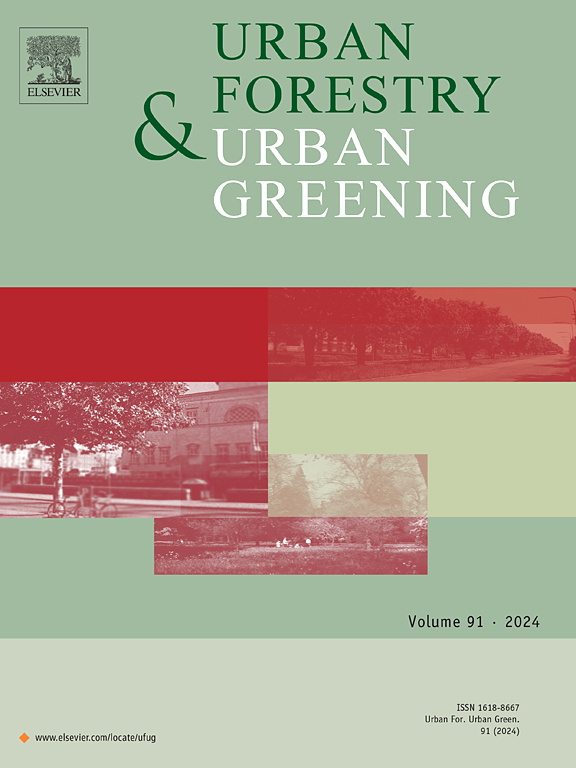The boreal soil microbiome of different urban green spaces – Do city residents meet different microbes?
IF 6
2区 环境科学与生态学
Q1 ENVIRONMENTAL STUDIES
引用次数: 0
Abstract
Soil microbes perform a wide range of functions, including nutrient cycling. Soils in urban green spaces also provide a nearby source of natural microbiota for human residents, potentially promoting the development of skin microbiomes and having beneficial impact on health. The soil of urban green spaces, which have distinctive vegetation characteristics, was analysed in two boreal cities to investigate whether residents are exposed to different microbial communities.
The analysis included built, open and forested green spaces. Built green spaces, characterized by flower beds and lawns, and open green spaces, such as meadows, had a similar soil microbiome, although this was an unexpected finding. The bacterial and fungal communities of urban forests differed from those of built and open green spaces. In contrast to the bacterial diversity of urban forests, which increased in the soil of built and open spaces, fungal diversity did not differ. According to metagenomic analyses all the green spaces were potentially denitrifying environments and revealed that all three urban spaces harboured genes that could possibly lead to the formation of more nitrous oxide (N2O) in urban forest soils. This finding highlights the importance of incorporating greenhouse gas flux measurements and functional microbial analyses in future research on the impact of urbanization on soil microbiology.
From the perspective of urban planning, our results indicate that the soils of built green spaces are microbiologically diverse, offering the potential to design different types of plantations that attract residents to urban parks of their choice. Furthermore, we recommend making efforts to preserve existing urban forests to provide opportunities for local populations to interact with alternative environmental microbiomes.
不同城市绿地的北方土壤微生物群——城市居民会遇到不同的微生物吗?
土壤微生物发挥着广泛的功能,包括养分循环。城市绿地中的土壤也为人类居民提供了天然微生物群的附近来源,可能促进皮肤微生物群的发育,并对健康产生有益影响。以两个北方城市为研究对象,分析了具有不同植被特征的城市绿地土壤,以调查居民是否暴露于不同的微生物群落。该分析包括建筑、开放和森林绿化空间。以花坛和草坪为特征的人造绿地与开放的绿地(如草地)的土壤微生物群相似,尽管这是一个意想不到的发现。城市森林的细菌和真菌群落与建筑绿地和开放绿地的细菌和真菌群落不同。城市森林的细菌多样性在建筑和开放空间的土壤中有所增加,而真菌多样性则没有差异。根据宏基因组分析,所有绿地都是潜在的反硝化环境,并揭示所有三个城市空间都含有可能导致城市森林土壤中形成更多氧化亚氮(N2O)的基因。这一发现强调了在未来城市化对土壤微生物影响的研究中结合温室气体通量测量和功能微生物分析的重要性。从城市规划的角度来看,我们的研究结果表明,人造绿地的土壤微生物多样性,为设计不同类型的种植园提供了潜力,吸引居民选择城市公园。此外,我们建议努力保护现有的城市森林,为当地人口提供与其他环境微生物群相互作用的机会。
本文章由计算机程序翻译,如有差异,请以英文原文为准。
求助全文
约1分钟内获得全文
求助全文
来源期刊

Urban Forestry & Urban Greening
FORESTRY-
CiteScore
11.70
自引率
12.50%
发文量
289
审稿时长
70 days
期刊介绍:
Urban Forestry and Urban Greening is a refereed, international journal aimed at presenting high-quality research with urban and peri-urban woody and non-woody vegetation and its use, planning, design, establishment and management as its main topics. Urban Forestry and Urban Greening concentrates on all tree-dominated (as joint together in the urban forest) as well as other green resources in and around urban areas, such as woodlands, public and private urban parks and gardens, urban nature areas, street tree and square plantations, botanical gardens and cemeteries.
The journal welcomes basic and applied research papers, as well as review papers and short communications. Contributions should focus on one or more of the following aspects:
-Form and functions of urban forests and other vegetation, including aspects of urban ecology.
-Policy-making, planning and design related to urban forests and other vegetation.
-Selection and establishment of tree resources and other vegetation for urban environments.
-Management of urban forests and other vegetation.
Original contributions of a high academic standard are invited from a wide range of disciplines and fields, including forestry, biology, horticulture, arboriculture, landscape ecology, pathology, soil science, hydrology, landscape architecture, landscape planning, urban planning and design, economics, sociology, environmental psychology, public health, and education.
 求助内容:
求助内容: 应助结果提醒方式:
应助结果提醒方式:


